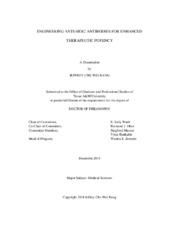| dc.description.abstract | HER2-postive breast cancer constitutes approximately 25% of breast cancer patients and leads to a worse prognosis. Antibody therapy, such as the anti-HER2 antibody trastuzumab, is used in the clinical setting to treat these cancers. Unfortunately, these cancers can resist trastuzumab treatment through ligand-mediated HER2/HER3 signaling. The first study addresses this issue by engineering a bispecific antibody targeting HER2 and HER3. A combination of immunoblots and proliferation assays were used to characterize the interaction between HER2, HER3, and the bispecific antibody. Another treatment for HER2-expressing cancers is the antibody-drug conjugate (ADC), trastuzumab emtansine (T-DM1). ADCs, however, suffer from a small therapeutic window due to a low maximum tolerated dose. The second study addresses this issue by engineering variants of the anti-HER2 antibody pertuzumab to bind HER2 tightly at neutral pH and weakly at acidic pH—termed acid-switched—using phage display and histidine scanning. Acid-switched antibodies were then used to generate ADCs that were characterized in vitro by flow cytometry, mass spectrometry, and cytotoxicity assays. Mice bearing tumor xenografts were treated with acid-switched ADCs to test their potency in vivo.
Ligand-induced HER2/HER3 dimers activate the PI3K/Akt signaling axis and individual treatments such as trastuzumab or the small molecule inhibitor lapatinib which targets HER2 phosphorylation are unable to prevent this signaling cascade. The bispecific antibody was constructed from trastuzumab and an anti-HER3 antibody with the goal of preventing HER2/HER3 dimer signaling. A combination treatment of the bispecific antibody and lapatinib significantly inhibited cancer cell proliferation in vitro.
Acid-switched ADCs were engineered to bind tightly to HER2 on the target cell surface and to dissociate after internalization into acidic endosomes. These acid-switched antibodies were observed to have at least an ~100-fold reduced binding affinity at pH 5.8 relative to pH 7.4. The difference in binding affinity led to enhanced accumulation of acid-switched ADCs and greater release of cytotoxic drug in HER2-expressing cancer cells in comparison to treatments with ADCs derived from the parent antibody. Mice implanted with the HER2-expressing cancer cell lines MDA-MB-453 and JIMT-1 showed tumor regression or slowed growth when treated with acid-switched ADCs in comparison to the parental ADC, respectively. | en |


